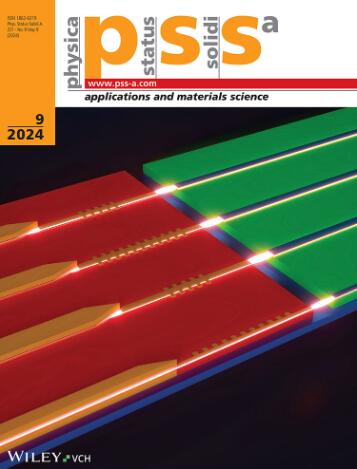化学浴沉积过程中 Cu2-xSe 电极的表面钝化
IF 1.9
4区 材料科学
Q3 MATERIALS SCIENCE, MULTIDISCIPLINARY
Physica Status Solidi A-applications and Materials Science
Pub Date : 2024-08-28
DOI:10.1002/pssa.202400510
引用次数: 0
摘要
在此,我们通过化学沉积法在聚酯/铜薄膜的 20、25 和 30 秒不同转换时间下制备出 p 型柔性透明 Cu2-xSe 电极。为了研究 Cu2-xSe 层上的电荷传输特性,按照以下配置生产了有机发光二极管(OLED):聚酯/Cu2-xSe/聚(3,4-亚乙二氧基噻吩):聚苯乙烯磺酸盐)/聚[2-甲氧基-5-(2-乙基己氧基)-1,4-苯基乙烯]/铝(聚酯/Cu2-xSe/PEDOT:PSS/MEH-PPV/Al),从而在空穴传输中实现直接隧道传输。通过控制 Cu2-xSe 电极和 MEH-PPV 聚合物之间的势垒能量,可以有选择地调整 OLED 的电荷传输机制。使用原子力显微镜对 Cu2-xSe 电极进行的形态分析,以及 OLED 中电流-电压测量的温度依赖性(50-300 K)显示了化学浴中的理想沉积时间。与此相反,阻抗光谱结果证实,在 Cu2-xSe 合成 30 秒后,Cu2-xSe/PEDOT:PSS 界面并不存在。因此,在通过化学浴沉积合成 Cu2-xSe 层的过程中,可以通过降低空穴传输的势垒能来控制电荷的注入机制,从而简化和降低器件的加工成本。本文章由计算机程序翻译,如有差异,请以英文原文为准。
Surface Passivation of the Cu2–xSe Electrode During the Chemical Bath Deposition
Herein, p ‐type flexible and transparent electrodes of Cu2–x Se are produced at different conversion times at 20, 25, and 30 s of polyester/Cu thin films via chemical bath deposition. To study the charge transport properties across the Cu2–x Se layer, the organic light‐emitting diodes (OLEDs) are produced according to the following configuration: polyester/Cu2–x Se/poly(3,4‐ethylenedioxythiophene):poly(styrene sulfonate)/poly[2‐methoxy‐5‐(2‐ethylhexyloxy)‐1,4‐phenylenevinylene]/aluminum (polyester/Cu2–x Se/PEDOT:PSS/MEH‐PPV/Al), resulting in a direct tunneling in the transport of holes. The control of the barrier's energy between the Cu2–x Se electrode and the MEH‐PPV polymer allows it to tune selectively of the OLED’ charge transport mechanism. The morphological analysis of the Cu2–x Se electrode, carried out using atomic force microscopy, as well as the temperature dependence of the current–voltage measurements in the OLED (50–300 K) shows the ideal deposition time in the chemical bath. In contrast, impedance spectroscopy results confirm the inexistence of the Cu2–x Se/PEDOT:PSS interface using 30 s to Cu2–x Se synthesis. As a result, the control of the injection mechanism of charges can be obtained by reducing the barrier energy to hole transport during the synthesis process of the Cu2–x Se layer via chemical bath deposition, thus simplifying and reducing the costs of the device's processing.
求助全文
通过发布文献求助,成功后即可免费获取论文全文。
去求助
来源期刊
CiteScore
3.70
自引率
5.00%
发文量
393
审稿时长
2 months
期刊介绍:
The physica status solidi (pss) journal group is devoted to the thorough peer review and the rapid publication of new and important results in all fields of solid state and materials physics, from basic science to applications and devices. Among the largest and most established international publications, the pss journals publish reviews, letters and original articles, as regular content as well as in special issues and topical sections.

 求助内容:
求助内容: 应助结果提醒方式:
应助结果提醒方式:


